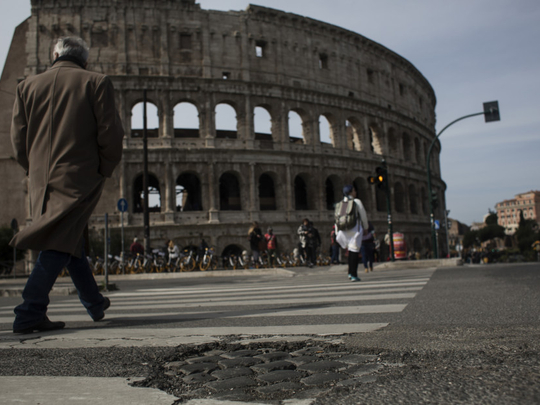
Rome: On a rainy Sunday morning, Cristiano Davoli stopped traffic and rushed into the middle of the street to save the day.
The 45-year-old comic book salesman, wearing a Patch Me logo across his chest, emptied a bag of asphalt into a deep and perilous pothole. He beat the pitch down with the back of a shovel. He pounded it with his boots.
“That’s called an emergency intervention,” said Davoli, a vigilante hero in the battle against the voracious potholes that have opened across the city.
All roads may lead to Rome, but when you get here the mean streets and wrecked pavements will puncture your tires, break your axels, herniate your discs, and in one recent case, swallow your SUV whole.
A poisonous Roman cocktail of chronic mismanagement, corruption, bureaucracy, neglect, heavy traffic, rare snow and constant rain has turned Rome’s roads into a modern ruin that has surpassed overflowing garbage, busted water pipes and striking bus drivers as the emblem of a degraded city in another decline.
Progressive jolts
First come the cracks, resembling spider webs. They give way to the grooved pattern of a dry desert floor. Ultimately gaping potholes open up. Camouflaged in a rainy March under cappuccino-coloured puddles, they twist ankles, topple zigzagging scooters and turn car rides into brain-rattling off-road excursions.
“It’s a disaster,” said Davoli, who has made filling potholes his personal mission, risking fines for filling them in unauthorised areas. His appeals to volunteer citywide have been ignored by the mayor.
The city has closed streets and reduced the speed limit in many places to an ancient Roman crawl. The potholes have caused untold accidents, hours of traffic and windfalls for tire dealers. One pothole was credited with shredding the tyres of 15 cars in under an hour. The perpetually embattled mayor, Virginia Raggi, this month inaugurated a €17 million (Dh77 million) “Marshall Plan” (not to be confused with February’s €90 million “Pothole Plan”) to patch up 50,000 potholes a month.
The city has unveiled its “Pothole Patching Machine,” which it claims can fill 150 potholes a day. And prosecutors have opened a broad investigation to get to the bottom of the crackup.
Romans say the problem has never been this bad, but the Raggi administration, which has been in power for nearly two years, blames its predecessors. Margherita Gatta, the city’s chief infrastructure official, said that the world’s other cities had lots of potholes too, but that it was “normal that the capitol makes news.”
Milanese always called Rome uncivilised. But now so do people in Naples.
Romans, conditioned by centuries of seen-it-all cynicism, sometimes even find themselves astonished.
In the Monteverde section of the city, Patrizia Ambrosini, 70, stopped to look at a five-metre chasm fenced off on the street. The ground had given way days earlier and engulfed a Daia Duster. “Well, this is a first,” she said.
‘Adopt a pothole’ Facebook page
Romans, who do not like walking but do not mind complaining, bemoan an abnormal situation. They have reacted by posting memes on the internet.
In one, Raggi is up to her lips in a puddle-filled pothole next to the words: “It’s OK. You can still stand.” In another, she takes credit for having built “4,000 swimming pools in Rome.”
Others show salmon leaping and alligators snapping out of wet potholes. One Facebook group has started an “adopt a pothole” page.
Real life is no less strange. One man spent an afternoon dipping a fishing line into a hole that seemed a small pond. (“Boss,” a passer-by shouted. “It’s no use!” )
Rome was not built in a day
► Earlier, and the earliest, Roman administrations seemed to care more about road maintenance. The Laws of the Twelve Tables, Rome’s first set of rules dating back to 450 B.C., included instructions to make straight roads 8 feet wide, stipulated what to do in case of water damage and decreed who “shall build and repair the road.”
► Around 300BC, Romans started building roads to move their troops, citizens and goods. Starting with the Appian Way, named after the censor who ordered its construction, Romans paved an empire. Revolutionary populist Gaius Gracchus helped build public streets because he understood the junction between a road and the rabble’s heart.
► Rome protected its streets by limiting chariot traffic and put a daytime ban on commercial carts. Julius Caesar fought to procure the position of temporary commissioner on the Appian Way, ancient stretches of which still stand. (Parts of the modern counterpart, the New Appia, do not.)
► After Rome collapsed, urban planning fell by the wayside for centuries. In the 1700s, Monsignor Ludovico Sergardi, who oversaw public works at St. Peter’s Basilica, helped introduce the bevelled black basalt cobblestones, known as sampietrini, which are central to the city’s charm. Lore has it that he started laying them down after potholes nearly overturned the pope’s carriage.
► These days, the sampietrini have proved treacherous for the city’s many scooters, slippery for dress shoes and murder for stilettos. And they require constant maintenance under heavy traffic.
► In the past decade the city’s streets have become an unattractive patchwork of asphalt, cobblestone, gravel and rubble.
► Papers lamented “Swiss cheese asphalt,” and Italy’s consumer association sued the city for using lousy materials that contributed to “pathologies for the vertebrae.” A corruption and bribery scandal exposed the plots that led to “the killer potholes.”
► During the filming of a James Bond film Spectre in central Rome, actor Daniel Craig banged his head inside his car’s interior after hitting a pothole with his speeding Aston Martin. He was filing a high-speed chase scene.
— New York Times News Service












